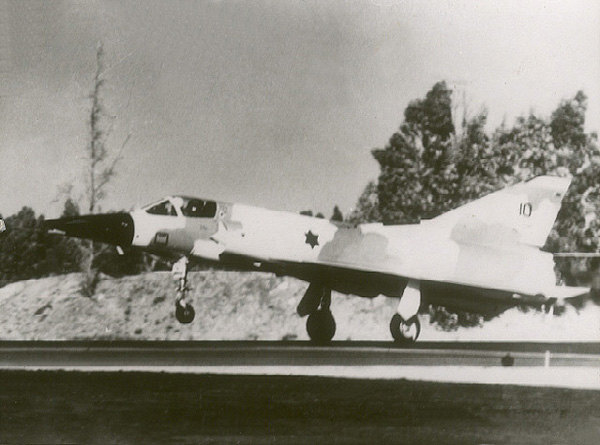|
|
Nesher |
|
| |

|
|
|
| The Nesher was the first fighter to be produced in Israel, thus paving the way for the appearance of more advanced planes like the Kfir and Lavi. The IAF saw the Nesher as a temporary expedient for reinforcing Israel's air power, a sort of intermediate phase before the more advanced models made their entry. When the better planes arrived upon the scene, the Nesher was phased out. The Neshers served in the IAF for just 10 years, and reached the apex of their glory in the Yom Kippur War, during which they scored numerous kills. |
| |
In Action |
| |
The first Nesher landed in the First Combat Squadron's base at Hatzor in May of 1971, with veteran test pilot Danny Shapira at the controls. In the months that followed, additional Nesher planes equipped this squadron, making up for the insufficient number of Mirage IIIs and raising the number of serviceable planes in the squadron. When the rate of production picked up at the Nesher assembly line at IAI, two new squadrons could be established, based solely on the Neshers. The first new squadron inaugurated 'Etzion Airbase at 'Bik'at Hayareakh' ('Valley of the Moon') near Eilat, in September of 1972, and the second was founded in March of 1973 at Hatzor.
When the Yom Kippur War broke out, in October of 1973, the IAF had 40 Nesher planes in its ranks, serving in the First Combat Squadron and in the two new squadrons. Although they were originally intended for attack missions, in the course of the war the Neshers were primarily used in air-to-air combat. The IAF command decided to use the Phantoms, Skyhawks and Sa'ars against ground targets, and assigned the Mirages and Neshers the task of fighting enemy aircraft and establishing air superiority over the battle zones.
The Neshers proved to be good fighters and overcame their adversaries (MiGs and Sukhois) with relative ease. According to the statistics published after the war, there were 117 dogfights in the course of the Yom Kippur War (65 over Syria and 52 over Egypt). 227 enemy planes were shot down in these confrontations, and only six Israeli planes were shot down (they had been on interception missions, and were either hit by cannon fire or by sirface-to-air missiles). The Nesher squadron from Etzion was one of the leading squadrons, tallying 42 kills without a single plane lost.
The Neshers did not just go out on interception missions: they also carried out several attack sorties in the Golan Heights and on the southern front. The action was intense, with every pilot carrying out numerous sorties every day.
The war proved just how vital the Nesher's reinforcement of the IAF's order of battle had been, and convinced the defense community of the importance of continuing to develop fighters in the IAI. In 1975 the first Kfirs entered service, and the Nesher was gradually relegated to a less central role. All the Neshers were concentrated in two squadrons, and were transferred - in late 1976 - to Eitam Airbase, whicch had been newly dedicated in the northern Sinai.
In the late 70's there were already enough Kfirs in the IAF for completely replacing the Mirages and Neshers. The Kfir was a significantly more advanced plane than the Nesher, boasting better performance as well as more sophisticated systems, and upgrading the Neshers was not deemed to be a worthwhile investment. In 1981, the Kfir had supplanted the Nesher in Heyl Ha'avir, and the Neshers were renovated, for sale overseas. Neshers were sold to Argentina, where they were renamed 'Dagger', and saw much action against the British in the Falklands War. |
| |
| |
Primary Role |
Multi-role single-seat fighter |
Original |
Israel |
Dimensions |
Wingspan: 8.22 m
Length: 15.55 m
Height: 4.25 m |
Capabilities |
Maximum speed: Mach 2.1
Service ceiling: 17,000 m
Max. range: 1,300 km |
Weight |
Empty: 6,600 kg
Max. loaded: 13,500 kg |
Power Plant |
SNECMA Atar 09 engine
with 4,280 kg. thrust |
|

|
